With Marcelo Bielsa taking over the Uruguayan national team — and the young starlets such as Thiago Borbas, Emiliano Martínez, Maximiliano Araújo, Facundo Pellistri and Matías Arezo, who featured in Bielsa’s first game(s) in charge, along with the country’s recent U20 World Cup win, it’s evident that there’s something exciting brewing in Uruguayan football at the moment.
After taking the Uruguay job, Bielsa explained his decision by stating: “I did not have to be convinced. I like the group that have represented the country in recent years… One of the things that I considered a lot is that I would not have a group of players like the ones Uruguay has at the moment in any other club that can offer me a job” — this endorsement wasn’t just kind words from the new boss, as our analysis aims to emphasise.
In our scout report, we will look at five of Uruguay’s most exciting U21 prospects. We believe the players we’ve profiled for this article can excel in the future, especially if Bielsa gets his hands on them for extended periods where he can try to mould them and develop them, similar to how he’s evolved stars such as current midfielder from the reigning UEFA Champions League/EPL champions Manchester City, Kalvin Phillips who worked with Bielsa during his time at Leeds United, current Arsenal star Ben White — who also worked with Bielsa at Leeds, Ander Herrera from Bielsa’s time at Athletic Club and Dimitri Payet from Bielsa’s time at Marseille.
This article isn’t an analysis of Uruguay’s best young players. There are plenty of other young Uruguayan players, such as Darwin Núñez, Ronald Araújo, José Giménez and Rodrigo Bentancur, who we also believe can thrive for La Celeste in the future. However, those names are already very well-known, so we’ve tried to shine a light on some slightly younger, less prominent players who we feel have what it takes to become household names among football fans around the world in the near future and could be good fits for Bielsa’s strategy and tactics with Uruguay.
All stats and data used in this analysis have been sourced from Wyscout.
Facundo González, 20 years old, Valencia Mestalla
First up in our analysis is 20-year-old Valencia Mestalla centre-back Facundo González (193cm/6’3”, 78kg/171lbs). González has featured 21 times for Uruguay’s U20 side and was part of their senior national team squad for their most recent friendly with Cuba but didn’t appear off the bench. Still, it would appear that this is a player Bielsa appreciates, and that’s not a massive surprise, as the young Valencia prospect could be a major star for La Celeste in the future.
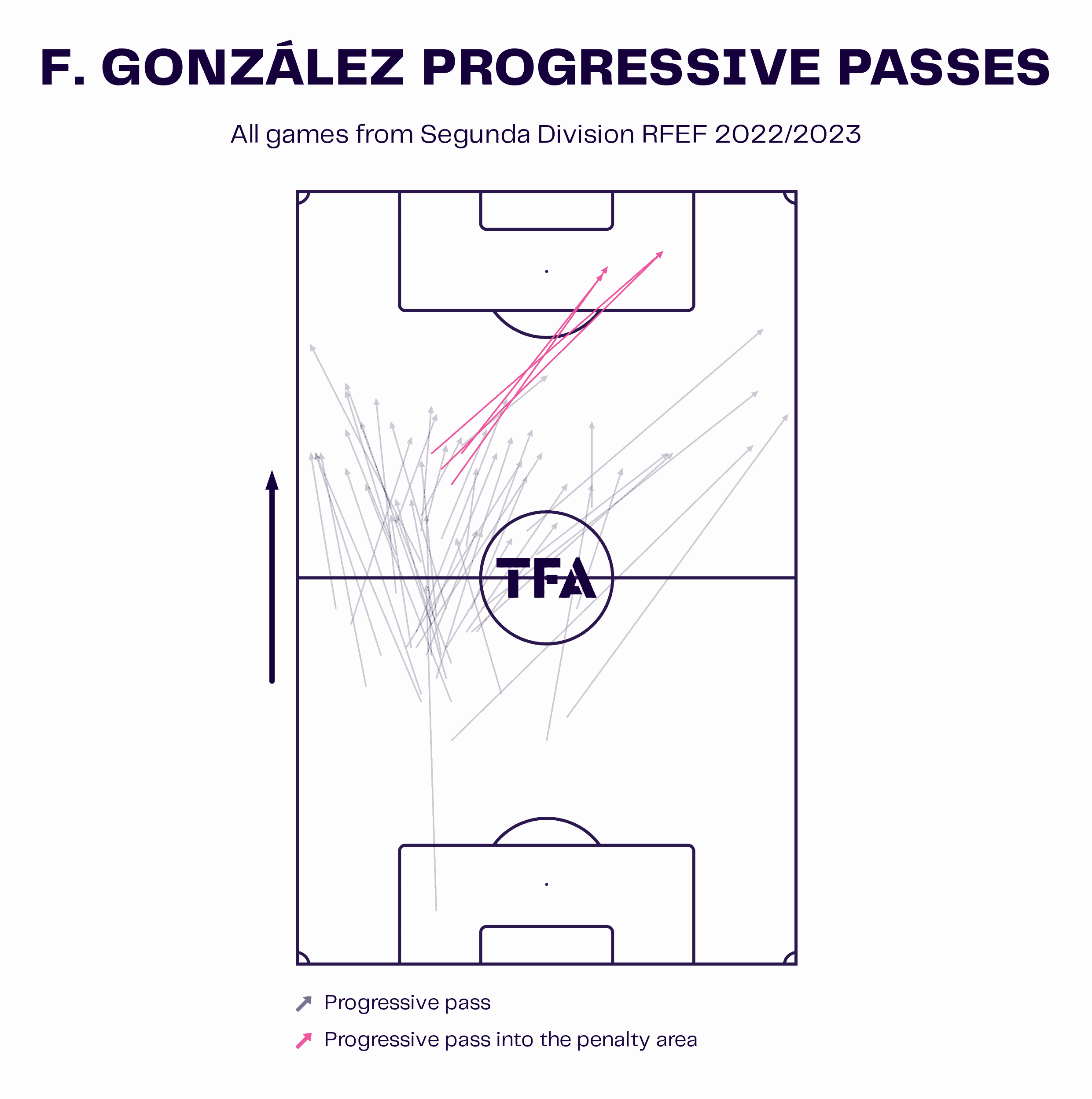
On the ball, González is a confident passer from the left centre-back position. Figure 1 shows the left-footed centre-back’s progressive pass map from last season to highlight this point further. The map indicates the types of positions he’s familiar with passing from and to. We can see plenty of long switches from left to right and penetrative passes into the left half-space, the wing or the ‘10’ position where a teammate can receive, turn and attack the opposition’s goal.
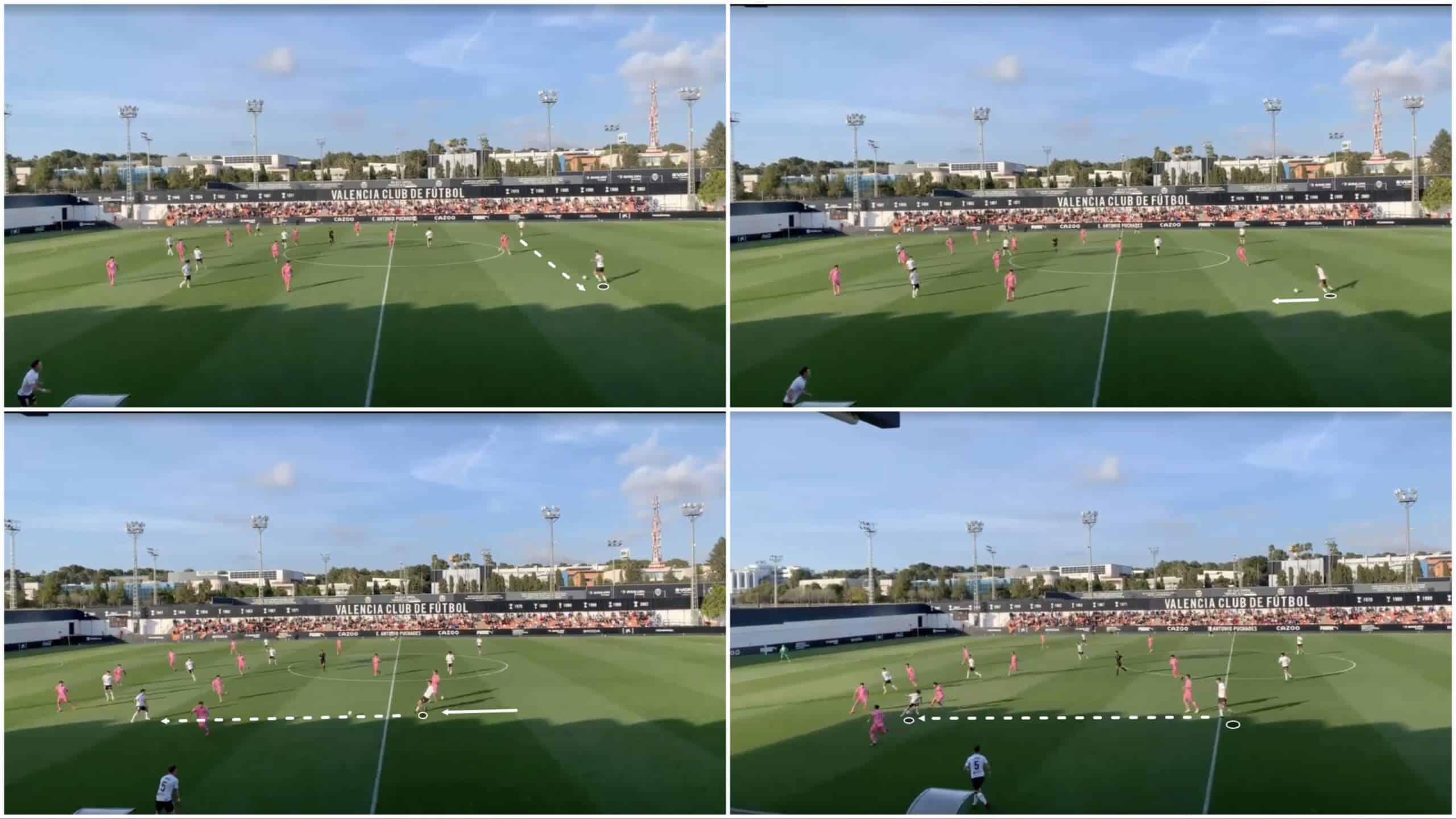
Figure 2 shows an example of a González pass along the left side of the pitch, finding a teammate in a more threatening position just ahead. Here, we see him receive, turn, carry a little bit and then release to the teammate positioned ahead in the left half-space between three opposition players. This pass and the teammate’s positioning helps Valencia to draw the defenders in, thus creating space elsewhere for the team to exploit.
This is just an example of how González likes to operate. He’s comfortable playing passes into high-value areas even if it’s risky and defenders are circling the receiver, or he needs to break a line to reach the intended target. He’s daring with the ball and likes to have the responsibility of driving the team forward, but he is still typically a reliable passer.
He generally plays his passes quite crisply along the ground but sometimes applies the wrong amount of power, making it more difficult for the receiver to control the ball and move forward.
All in all, with 11.48 progressive passes in all senior competitions for the last calendar year and 74.32% progressive passing accuracy, González performs exceptionally well in this area among his peers.
Defensively, González generally displays good positioning and uses his body well to prevent dribblers from continuing towards goal or even turning at times; he’s good at reacting to dribblers’ changes of direction too, making him and his large frame a difficult obstacle for many dribblers to get past.
González usually prefers a more standoffish defensive approach — he won’t rush into challenges and chase attackers down; instead, he likes to defend space and enter any defensive engagement on his terms.
Pedro Milans, 21 years old, Peñarol
Our next player is the full-back from our list: 21-year-old Pedro Milans (171cm/5’7”, 67kg/147lbs). The Peñarol right-back has made a good name for himself with his club in Uruguay’s top flight over the last calendar year. He is one of the most promising full-backs in all of Uruguayan football — undoubtedly one to watch for Bielsa as he settles into life in the Uruguay hot seat.
On the ball, Milans can be a creative threat from the right wing through his crossing ability. The full-back varies up his crossing quite a bit, sometimes floating the ball in from deeper positions and sometimes drilling it into the danger zone from more advanced positions. In general, I’d say most of his crosses are played from slightly deeper with Peñarol, and he seems comfortable with this, often seeking out opportunities to send the ball in early.
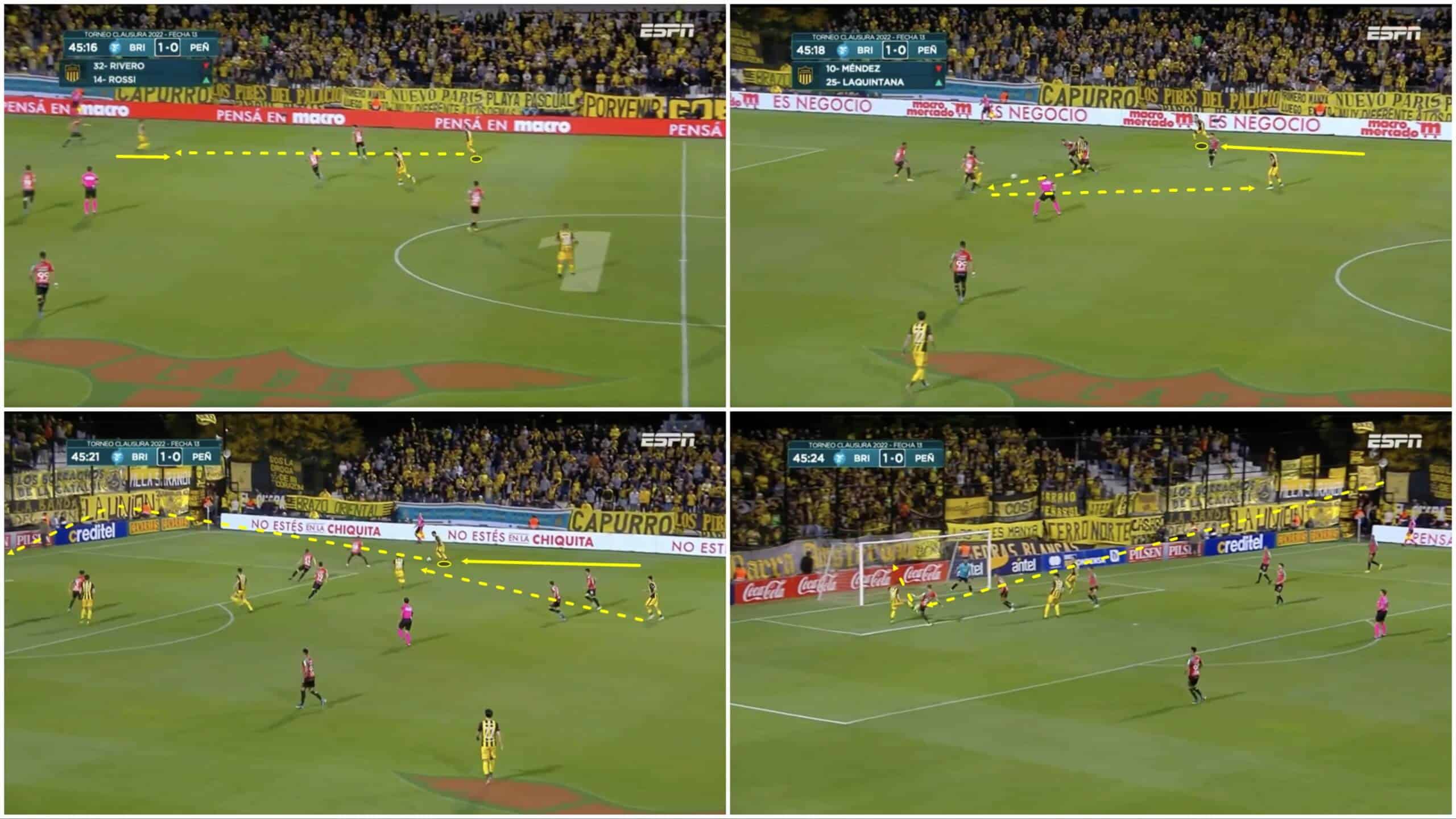
Figure 3 here provides a great example of Milans’ crossing tendencies. In this case, he progressed the ball up the right wing and into a good position for two attackers to quickly combine while attracting opposition defenders towards them before playing it back to a deeper midfielder. All the while, Milans was driving forward on the overlap to continue Peñarol’s march into the final third.
As the right-back receives again — this time in a more advanced position — he floats the ball into the danger zone and puts it invitingly on a plate for the attacker in the box to attack and, as we can see in the bottom-right image above, tuck away into the net.
Milans enjoys crossing from wider and deeper positions where he can really whip the ball in, which is aesthetically pleasing and, most importantly, very effective at creating problems for the opposition. He’ll be a pleasure for strikers to work with, especially big attackers with a strong aerial presence.
Milans is also quite effective and technically sound in terms of his dribbling. He’s good at drawing defenders in before, at the very last moment, knocking it ahead, out of their reach, allowing him to continue the attack, making him a tricky dribbler to close down effectively.
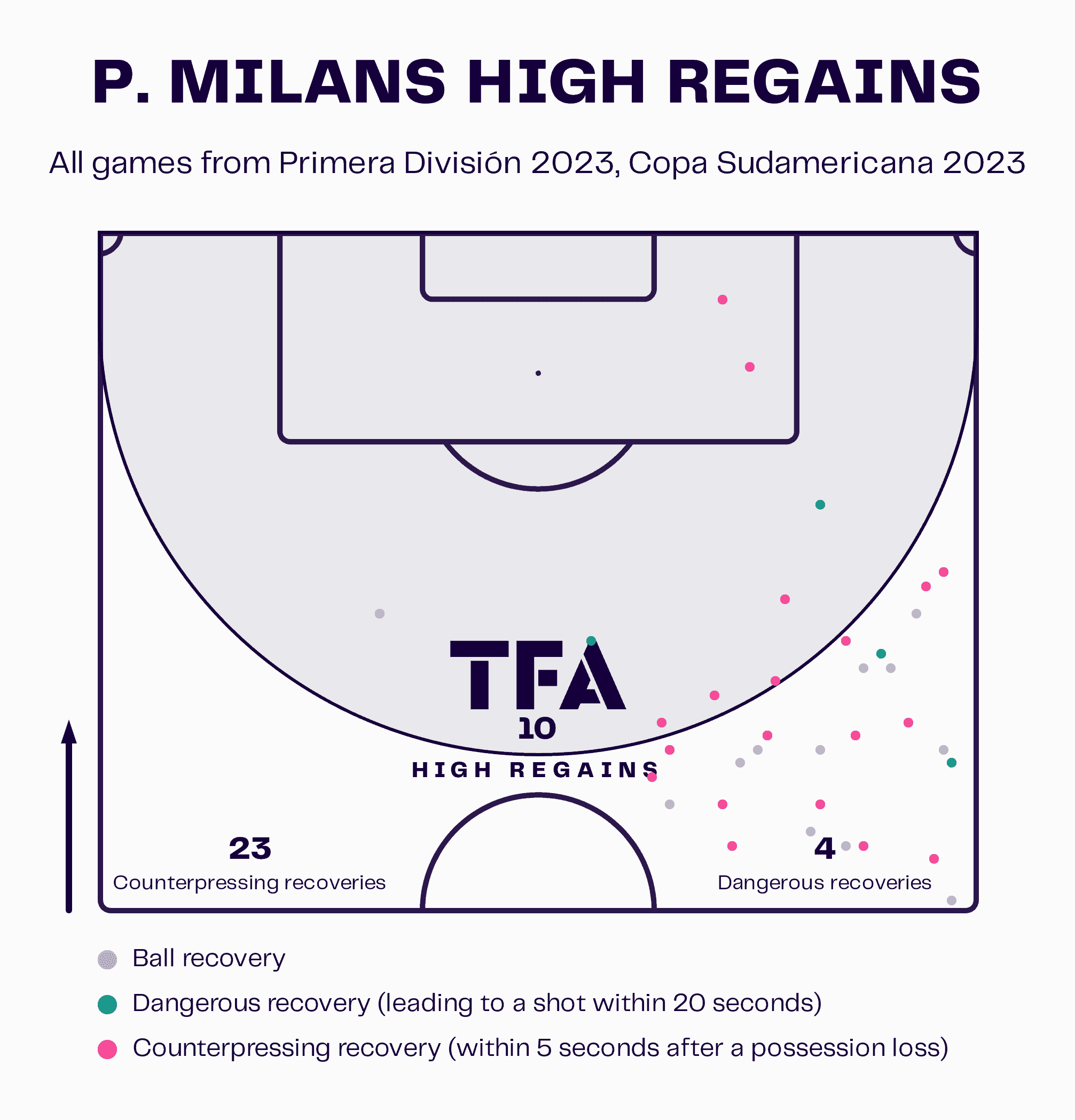
Defensively, Milans is an excellent asset in counterpressing, as figure 4 would indicate, with counterpressing recoveries dominating the high regains map here. He’s an aggressive defender with a high defensive work rate; he demonstrates good aggression in his defensive work.
His strength sometimes lets him down, and he can be beaten in physical duels. Furthermore, he’s pretty quick to dive into challenges, so he can be drawn in by the opposition quite easily, making him a vulnerable target for tactics such as that which he typically performs himself on the ball or progressive passes played into dropping attackers. All of this can create space behind Milans that the opposition can exploit.
The Peñarol man doesn’t have a very long stride, so he can be beaten in a sprint if the opposition do get space to exploit behind him, so this is an area he needs to watch out for. Perhaps he should try to be more careful about jumping into challenges too soon and account for the fact he may need to give himself an extra yard to cover the space in behind. Alternatively, his team just needs to be aware of this tendency and provide appropriate cover for him.
Fabricio Díaz, 20 years old, Liverpool Montevideo
Next up is 20-year-old central midfielder Fabricio Díaz (176cm/5’9”, 72kg/158lbs) from Liverpool Montevideo. Díaz starred for Uruguay in their recent U20 World Cup victory, featuring in every game for La Celeste and captaining the side to glory. All of this earned him a call-up to the senior squad for their recent friendly clash with Cuba.
Díaz can play as a ‘6’ or an ‘8’; he will typically either feature on the right side of a midfield three or the right side of a double-pivot. It’s probably best not to play him as a lone holding midfielder just because he thrives when given the license to drive forward with the ball, and this is an integral part of what makes him so good.
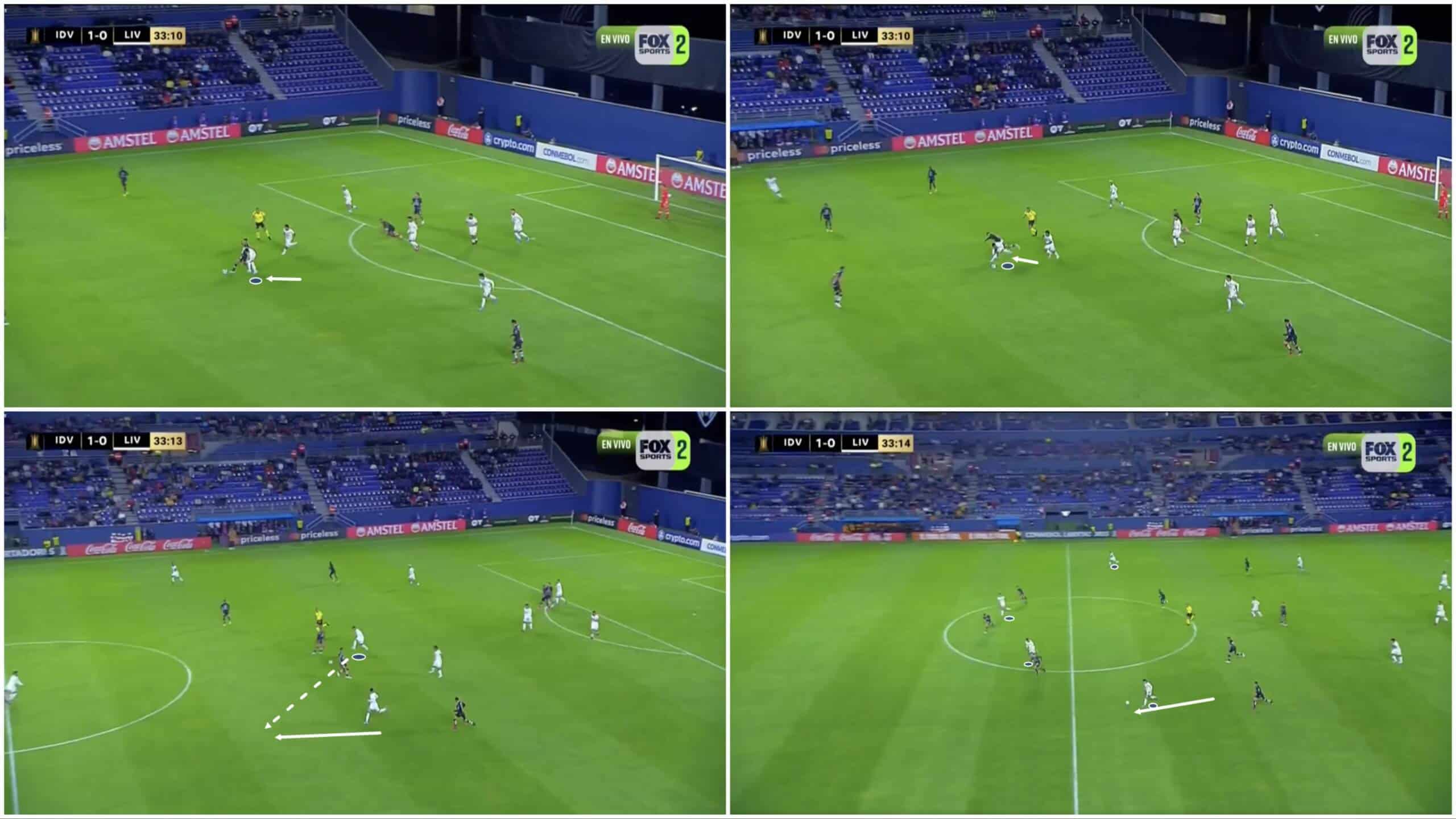
Figure 5 provides a great example of what Díaz is all about. He’s a box-to-box presence who can contribute significantly in quickly transforming defence to attack. Above, we see him fighting with an opposition player inside his own third in a 50/50 duel that he ultimately comes out on top of by outmuscling the opponent and creating space for himself to carry forward.
Once he settles on the ball and gets forward a few steps, the midfielder spots an opening between two opposition midfielders ahead of him, which he exploits with a very well-weighted through ball played into the path of a surging forward run from a teammate supporting the counterattack.
The inviting pass meets its intended target, and Díaz’s team end up in a very healthy position on the counter with four attackers moving towards goal and just three defenders back to try and stop them. This was all made possible by the work of Díaz, first in winning the ball back in the 50/50 duel and then splitting the opponent’s midfield open, demonstrating his technical quality and vision on the ball.
While Díaz is sometimes beaten in physical duels, he always contests them with an adequate level of aggression and energy. The midfielder is good at using his body to protect the ball from defenders and fight for control under pressure.
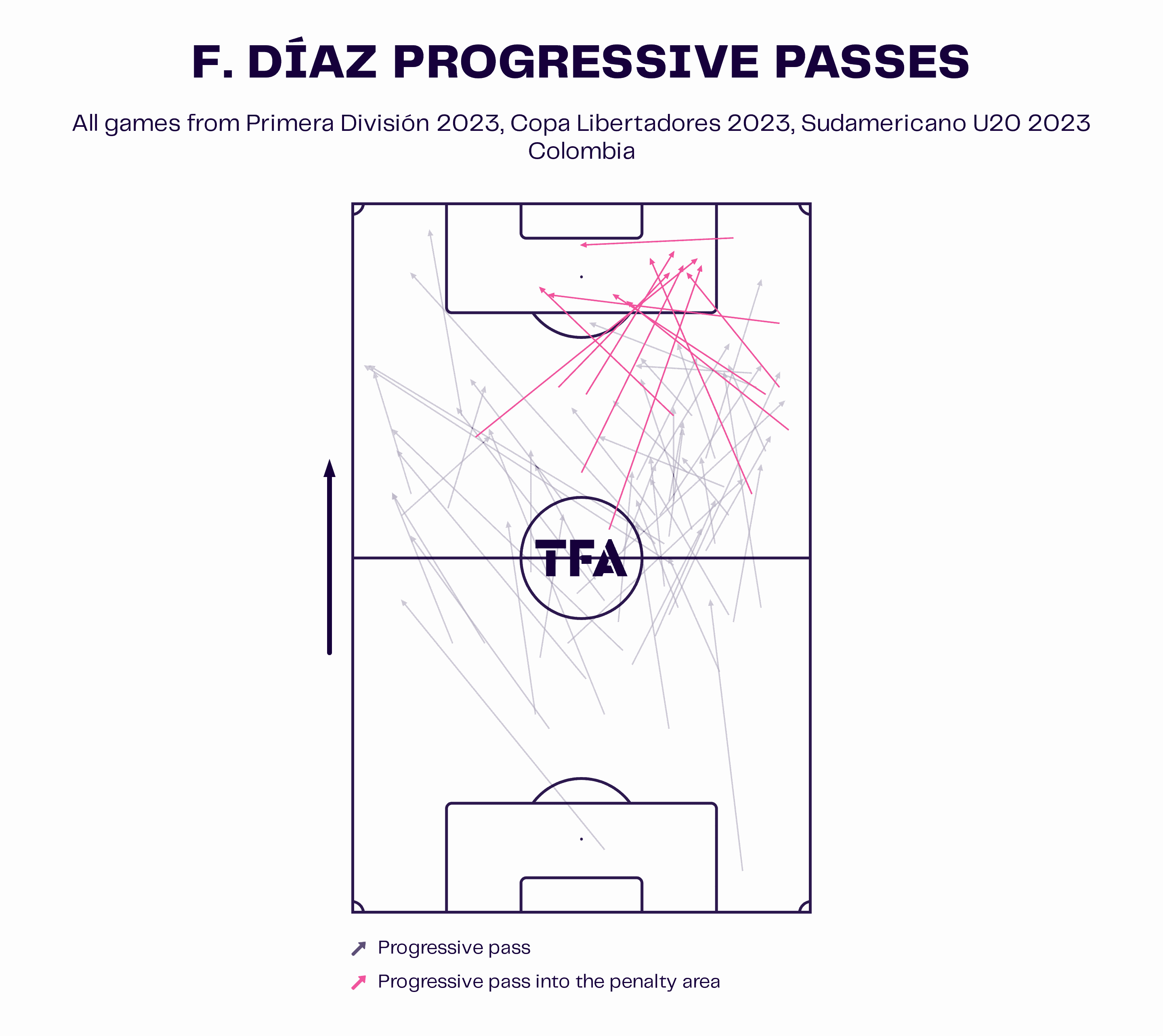
Díaz is a helpful presence in the middle of the park for driving his team forward, whether that’s by stabbing passes directly into the receiver’s feet in the final third or gently guiding the ball through into the path of runners ahead of him, with the latter being the slightly more common way of seeing Díaz progress his team forward.
The 20-year-old shines in transition to attack, meaning he often has the opportunity to play the ball ahead of runners offering support just in front of him while moving towards the opposition’s goal.
Luciano Rodríguez, 19 years old, Liverpool Montevideo
Next up, we have another Liverpool Montevideo player in Luciano Rodríguez (179cm/5’10”, 79kg/174lbs). Another player who shone for Uruguay in the recent U20 World Cup, Rodríguez actually scored the winning goal in the final to help La Celeste to victory over Italy. Again, perhaps as a reward for his achievement, he featured in the squad for Uruguay’s recent friendly with Cuba, and maybe this is a sign of things to come under Marcelo Bielsa, with Rodríguez possessing significant potential.
This teenager is a high-volume dribbler and an enjoyable player to watch. Like midfielder Díaz above, Rodríguez’s teammate for club and country, the attacker is an advantageous asset in offensive transitions. His pace, movement and technical dribbling quality all make him a standout in this area of the game. However, the 19-year-old is also very useful for breaking down a settled defence — again, his movement and dribbling are critical areas of his game in this regard.
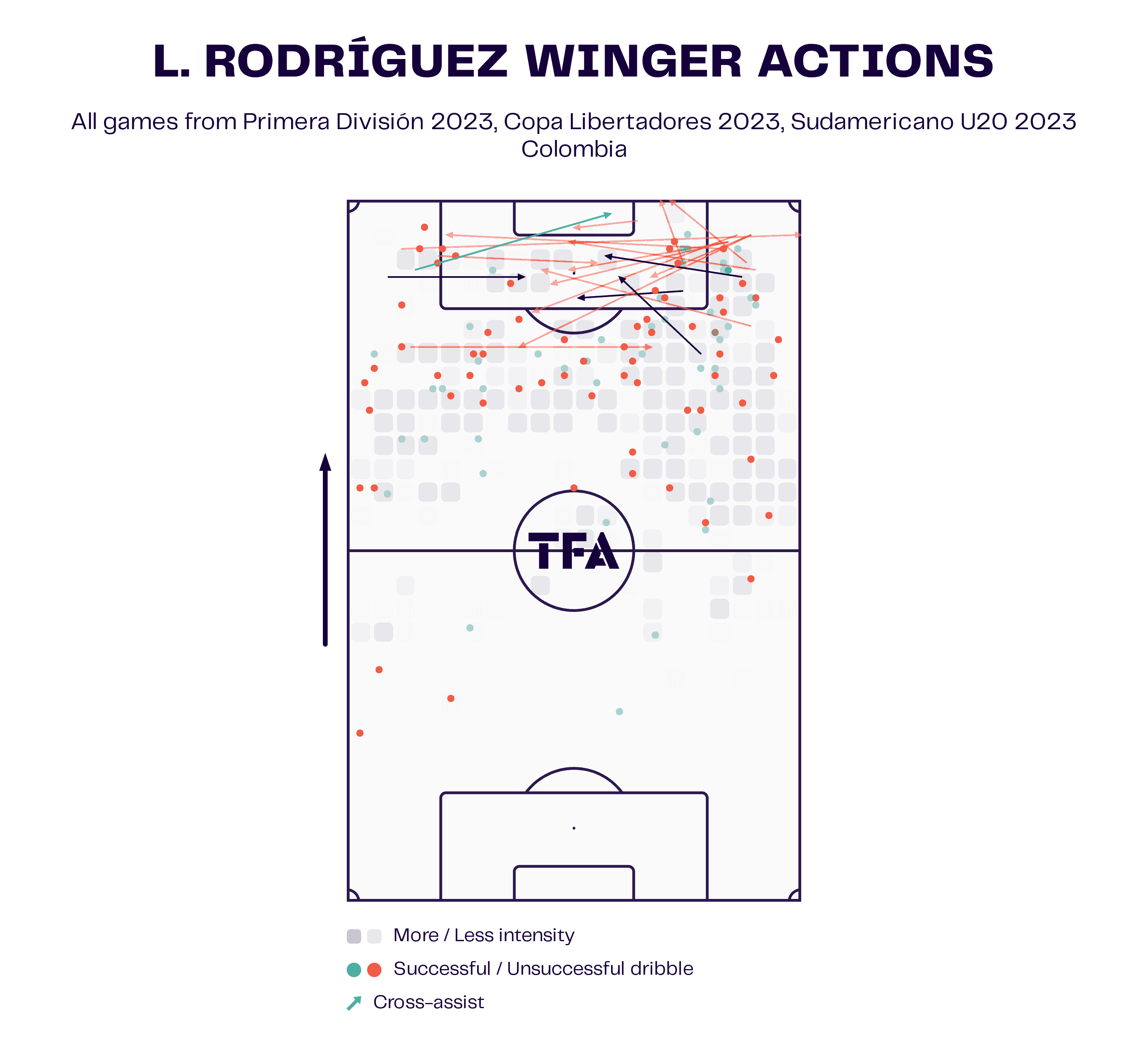
Figure 7 provides an overall view of the areas Rodríguez tends to occupy, cross from and dribble in. While there’s a slight tendency for the attacker to veer towards the right wing, we can see that he spends plenty of time all across the forward line.
The Liverpool Montevideo man is very positionally flexible, which is a trait Marcelo Bielsa will likely appreciate. He’s comfortable on either wing or even through the centre. He likes to react as space appears for him to invade with his off-the-ball movement to give deeper players such as Fabricio Díaz a good target to aim for balls into feet in the final third. He can perform well in a system that gives him the freedom to roam and move concerning the space and situation. Still, he’s a young and malleable player that will benefit from sitting under Bielsa’s learning tree.
The 19-year-old is a very difficult dribbler to defend against because of his combination of speed, agility and two-footedness. When in possession on the wing, he quickly weaves in and out, shifting the ball from one foot to the other and keeping the defender guessing. Furthermore, as the right-footed attacker is so comfortable with his weaker foot, it can be challenging to predict which side he will exit when dribbling. This can buy him an extra half a second or so that more predictable dribblers don’t have.
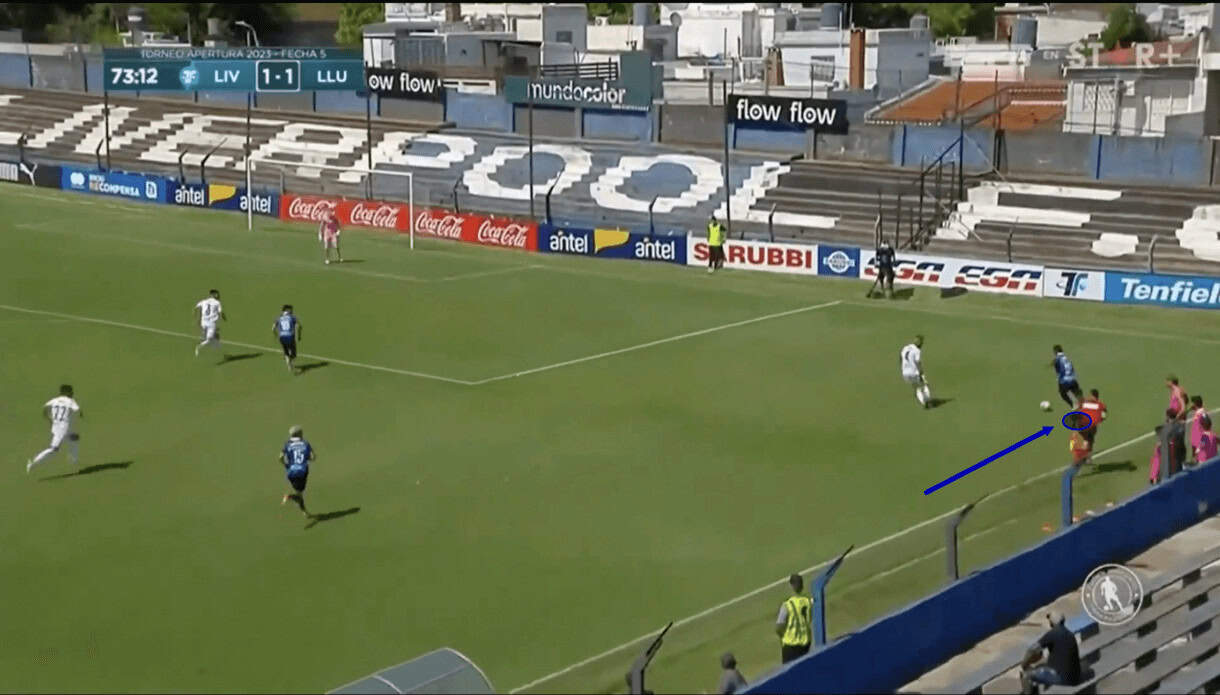
When dribbling, it’s common to see him driving down the wing with the ball and shaping up as if he’ll cross, as seen in figure 8 above. Thanks to his pace, he’s managed to get ahead of the defender, opening up the space to potentially cross.
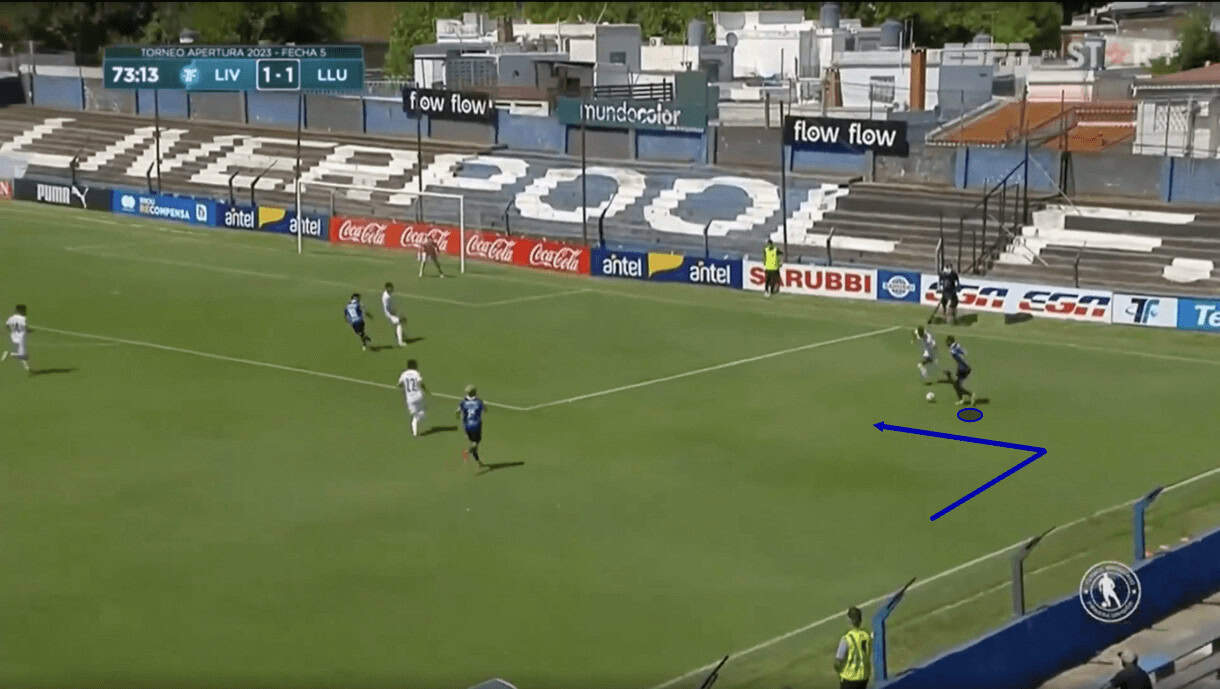
However, as play moves on, we see that Rodríguez ended up cutting the ball back onto his left foot, wrong-footing the defender completely and buying himself time to continue carrying towards the box. This is one of the more common specific dribbling techniques in his game that the teenager likes to use to great effect when looking to carry into the box or buy his team time to get more bodies forward.
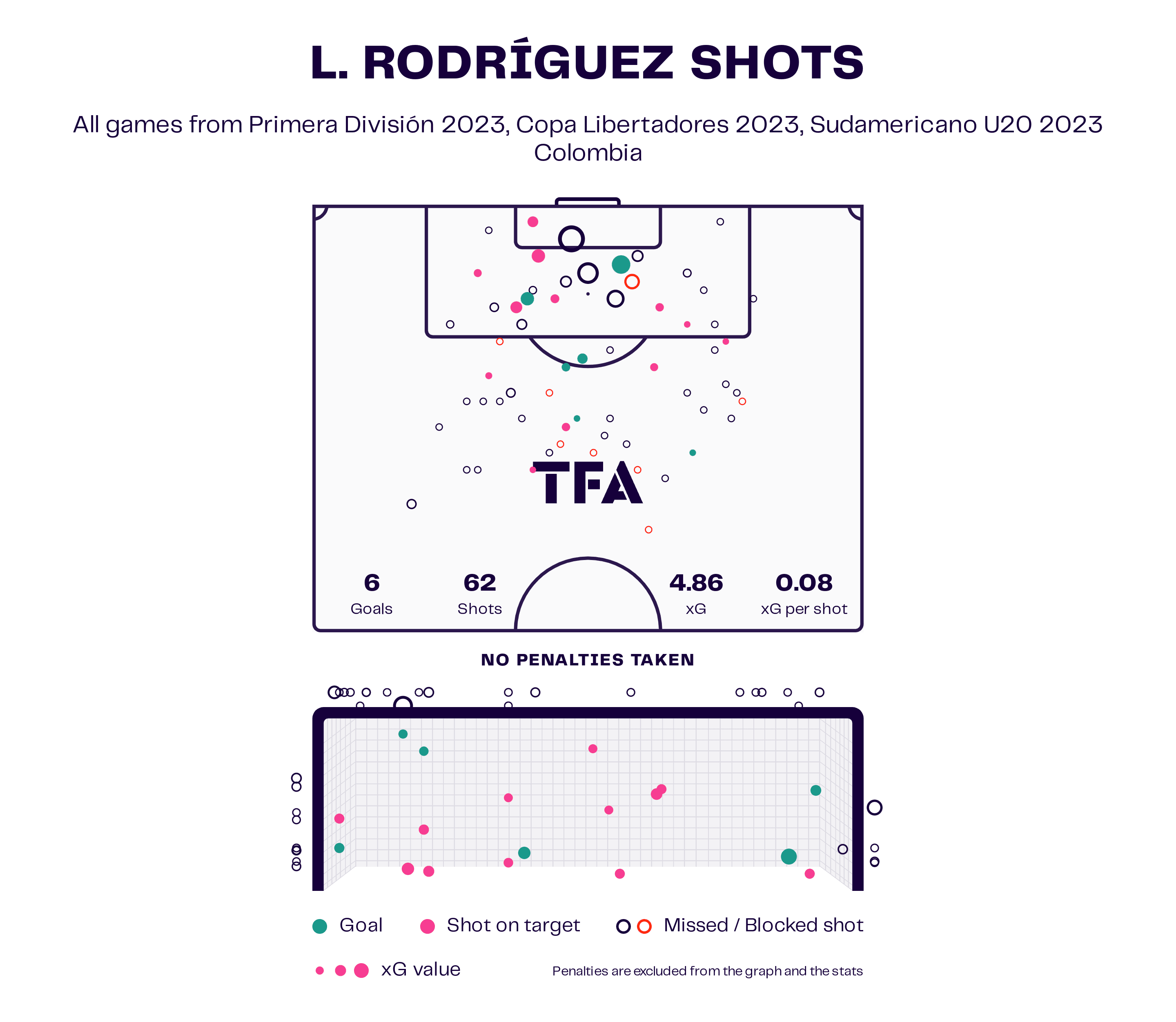
Rodríguez’s shot map doesn’t make for very pretty reading. Indeed, the attacker’s decision-making when it comes to shot-taking needs improving. Far too often, the 19-year-old opts to shoot prematurely, which can be quite wasteful.
Of course, a few of his long shots have resulted in goals on the above shot map, so this isn’t to say he’s terrible at shooting. However, some of his decision-making can be selfish at times and sees him passing up better playmaking opportunities for the opportunity of seeing his name lit up. This results in a fairly poor 0.08 xG per shot, which can easily be improved.
Álvaro Rodríguez, 18 years old, Real Madrid Castilla
Our fifth and final player in this team-focused scout report is Álvaro Rodríguez (193cm/6’3”, 82kg/180lbs) of Real Madrid Castilla. The 18-year-old didn’t feature in La Celeste’s U20 World Cup squad but has featured for the Uruguayan U20s eight times before. However, he played for Spain at U18 level and was born in Palamós, so perhaps Bielsa will have a fight on his hands to keep Rodríguez as an option.
This is a fight well worth contesting due to the teenager’s ability and potential. He’s already featured for Real Madrid’s senior squad eight times, scoring once and providing one assist in those eight appearances, totalling just 103 minutes. The attacker showed some of his best abilities in those senior appearances, highlighting why he can be a star for Uruguay in the future if his loyalty remains with the U20 world champions.
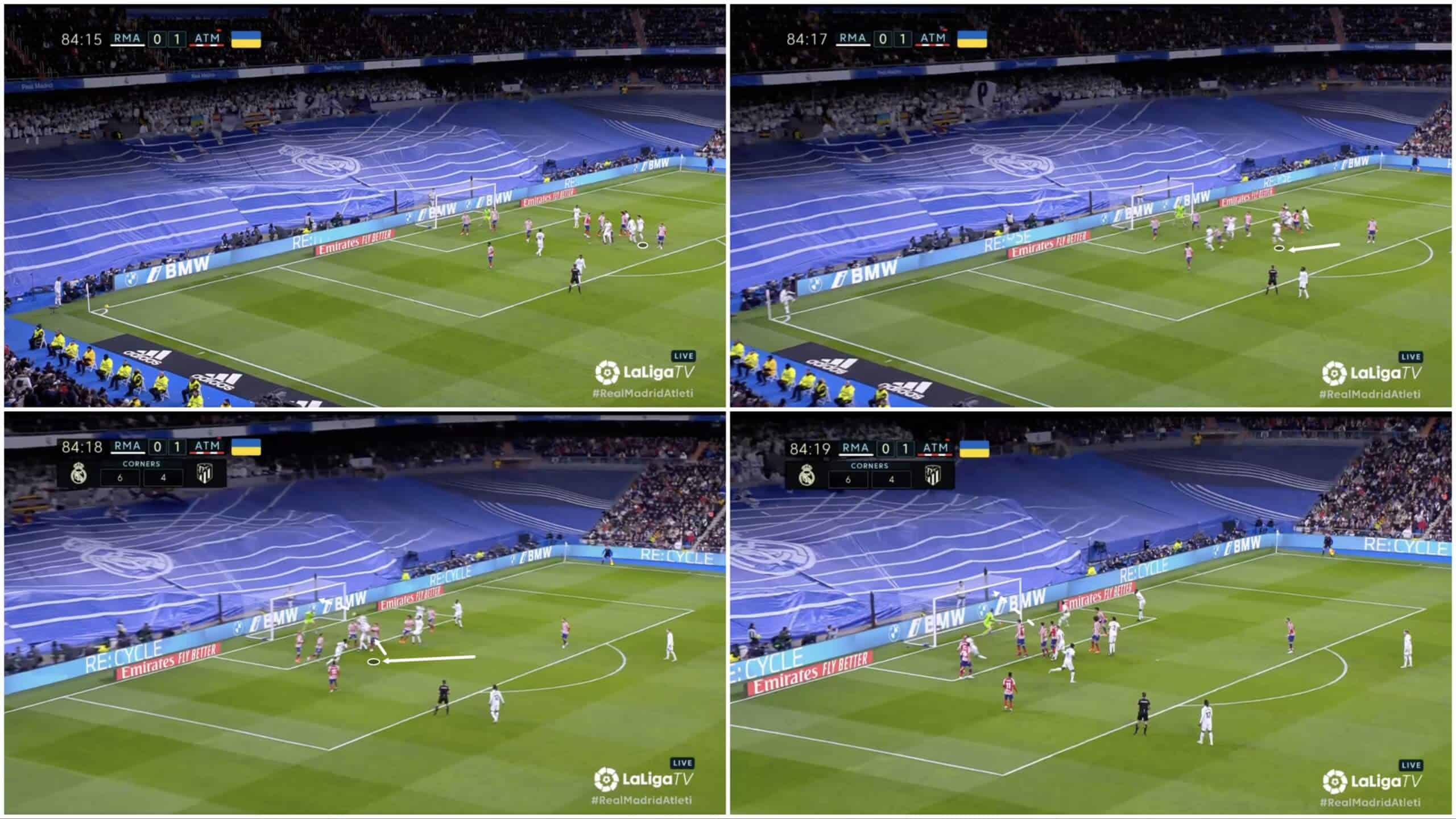
Firstly, Rodríguez’s first senior goal for Real Madrid came from a corner kick where the 193cm striker demonstrated his impressive movement and aerial ability. Firstly, he lost his marker before then making a dangerous run across the box to meet the cross and launch himself over everybody else to direct the ball goalwards, putting his side level in El Derbi Madrileño.
The Uruguayan teenager is an excellent athlete, and jumping ability like this would make him an excellent option to have in the box, with the likes of Pedro Milans targeting him from the wing.
Álvaro Rodríguez is a forward with a wide variety of finishes in his game and excellent shooting technique. The left-footer tends to occupy space in dangerous areas and find himself in good goalscoring positions thanks to his intelligent runs. This makes life easier for the playmakers in his side as he’s great for giving them a good option with great regularity.
You won’t just find Rodríguez centrally; he often pulls off out into wide areas and/or drops off to receive to feet and link up with the midfield, demonstrating similar positional versatility to Luciano Rodríguez and potentially giving Bielsa a very flexible forward line.
Rodríguez isn’t much of a crosser or a line-breaking passer, but his hold-up play is good and he’s capable of setting up teammates in good goalscoring positions via little layoffs with his back to goal.
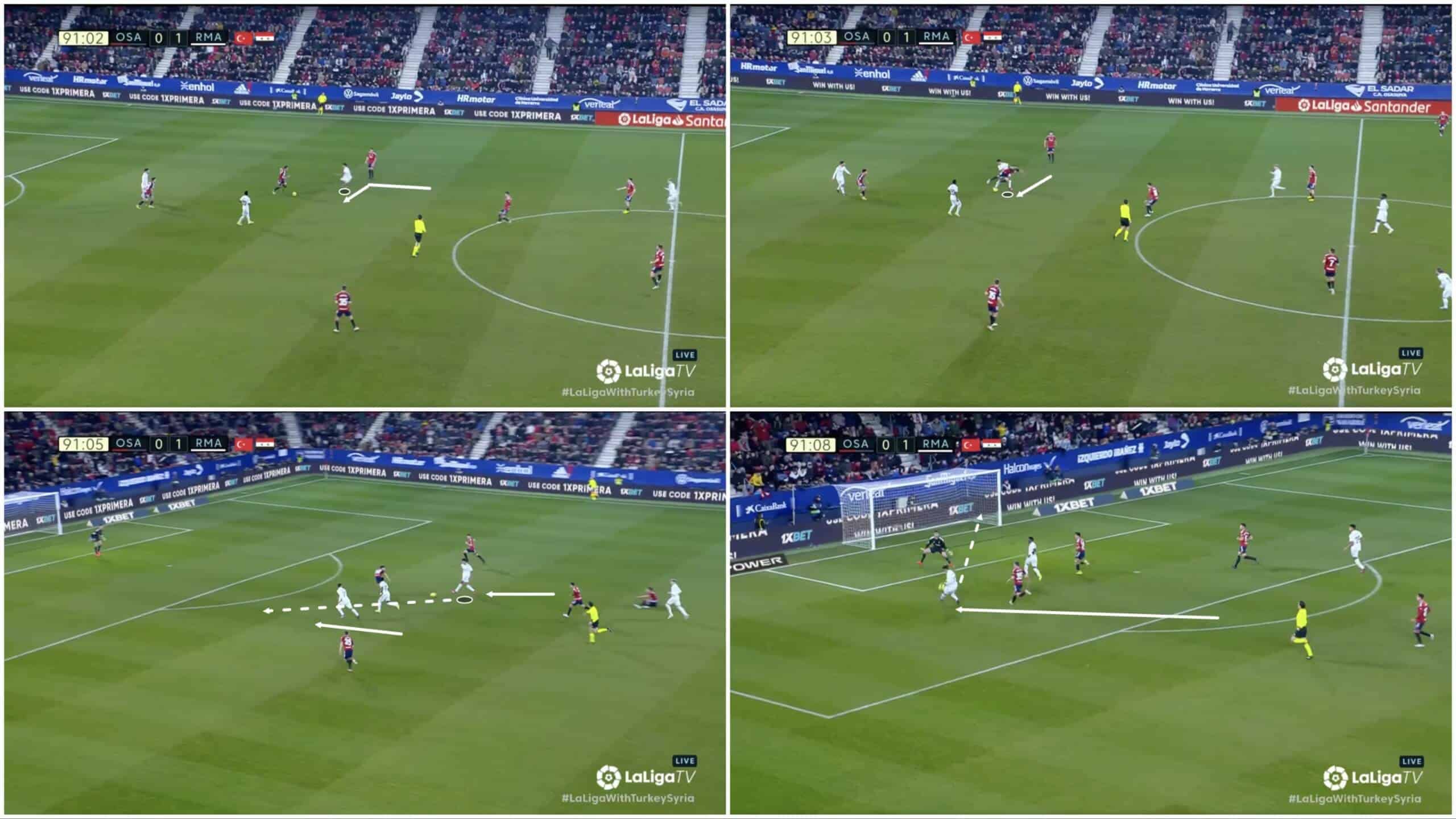
The 18-year-old can show more without the ball regarding his pressing, but he has demonstrated decent ability in this area. For instance, his first assist for Real Madrid’s senior team came as a result of some very nice pressing — first, closing the passing angle and then charging down the ball carrier, helping him to create a nice transition in an advanced area, allowing him to set a teammate up to put Los Blancos two goals to the good late on.
Bielsa’s centre-forward generally needs to be the first defender, and this is not an area where Rodríguez is sure to contribute at the required level right now. Still, it’s an area where plenty of growth is possible, especially if the teenager trains under the legendary coach.
Conclusion
To conclude this tactical analysis piece, we hope we’ve provided you with a few exciting names to keep tabs on over the next couple of years and shared some insight on the upcoming Uruguayans who could have an important few years on the horizon if Bielsa takes to them.
The relatively small South American nation of just around 3.5m people has never been short of footballing talent, and this indeed remains true today, with the five players discussed in this analysis only representing some of the country’s most exciting talents at the moment. With a new generation coming up and none other than Marcelo Bielsa steering the ship, the future is bright for La Celeste.





Comments